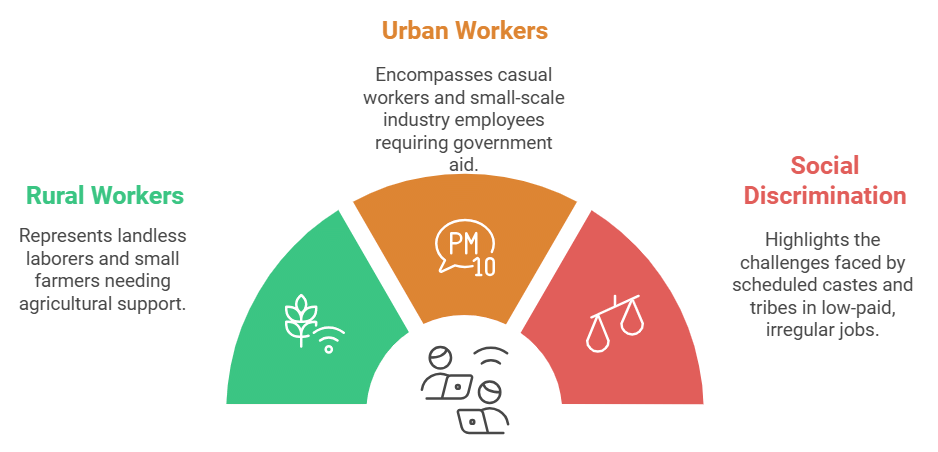Class 10 Economics Chapter 2 Notes - Sectors of the Indian Economy
Sectors of Economic Activities
- Sectors are communities of individuals engaged in various activities, including creating goods or services. These economic activities generate income and profit.
- For instance, a farmer cultivates crops to sell for profit, while an industry produces goods or services for consumers to make money.
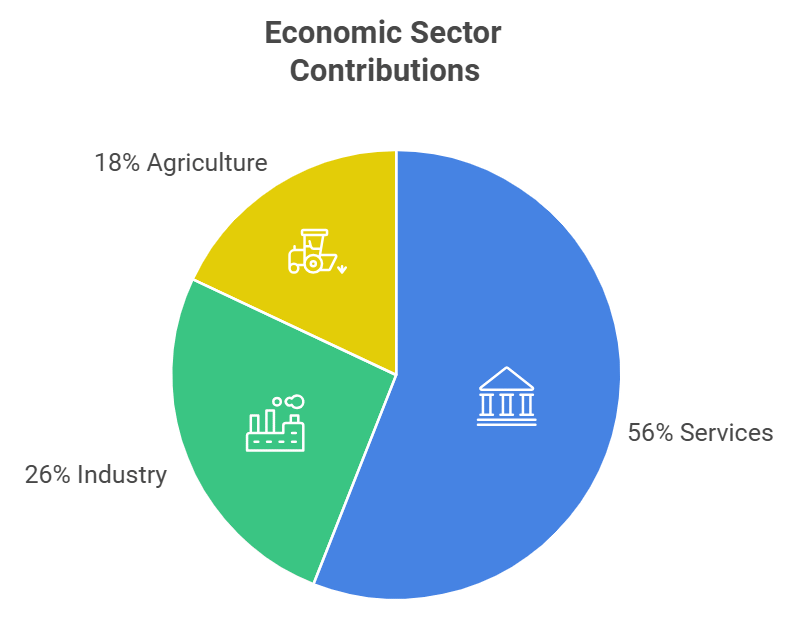
This pie chart shows the distribution of contributions from different sectors to the economy.
It is divided into three main sections: Services, Industry, and Agriculture.
Services: This is the largest section, taking up 56% of the chart. This means that more than half of the economy's output comes from the services sector, which includes things like banking, education, healthcare, and IT services.
Industry: The next largest section is Industry, which contributes 26% to the economy. Industries involve manufacturing, construction, and other activities that produce goods.
Agriculture: The smallest section, at 18%, is Agriculture. This sector involves farming, fishing, and forestry.
Overview of Sectors
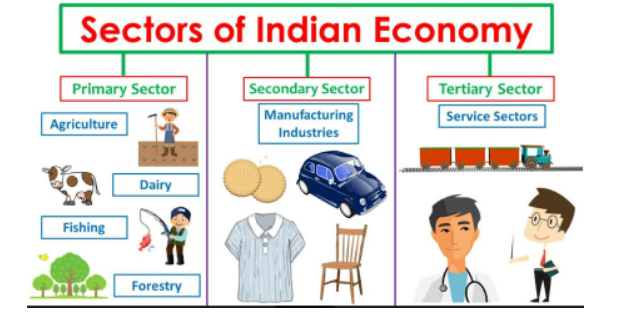
1. Primary Sector
Activities involving the direct use of natural resources.Examples:
- Agriculture: Cultivation of cotton (depends on rainfall, sunshine, climate).
- Dairy: Milk production (depends on biological processes and fodder).
- Mining: Extraction of minerals and ores.
Characteristics: Forms the base for other products; also known as agriculture and related sector.
2. Secondary Sector
Activities where natural products are transformed into other forms through manufacturing.Examples:
- Textiles: Spinning yarn and weaving cloth from cotton.
- Food Production: Making sugar or gur from sugarcane.
- Construction: Converting earth into bricks and using bricks for building houses.
Characteristics: Involves manufacturing processes; also known as industrial sector.
3. Tertiary Sector
Activities that support the development of primary and secondary sectors by providing services.Examples:
- Transport: Moving goods by trucks or trains.
- Storage: Warehousing goods.
- Communication: Telephone and postal services.
- Banking: Financial services for production and trade.
- Trade: Wholesale and retail selling.
Characteristics: Generates services rather than goods; also known as the service sector.
Comparing the Three Sectors
Each sector contributes to the economy's total output of goods and services. The proportion of goods and services produced and the number of people employed can vary across sectors. Some sectors may dominate in production and employment, while others remain smaller.
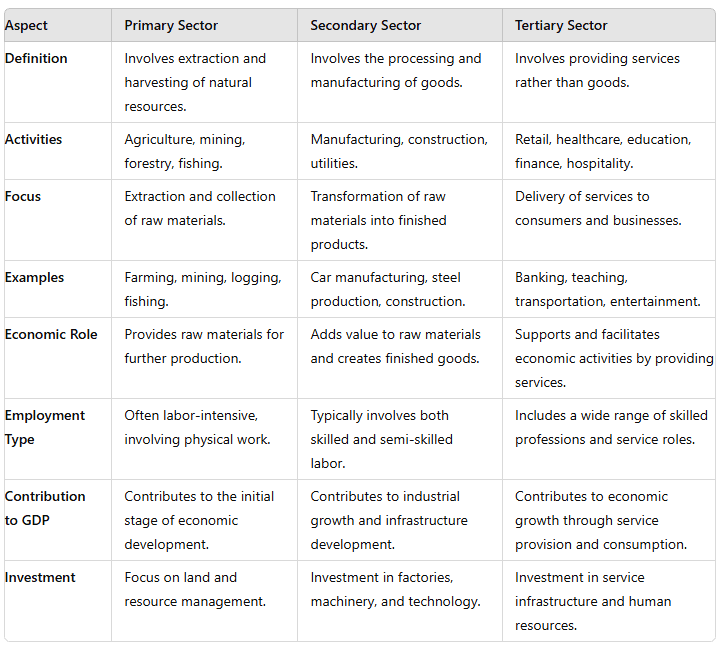
Gross Domestic Product (GDP)
- It is important to include only the final goods and services.
- The total value of final goods and services produced in each sector during a specific year represents that sector's production for that year.
- Adding up the production from various sectors results in what is known as the Gross Domestic Product (GDP) of a country.
- This indicates the value of all final goods and services produced within a country in a given year.
- In India, a central government ministry is responsible for measuring GDP. This ministry, along with various government departments from all Indian states and union territories, collects data on the total volume of goods and services and their prices to estimate GDP.
- Recently, the Indian Government started reporting the contributions of three sectors towards Gross Value Added (GVA) instead of GDP to align with global standards. The GVA reflects the contribution of these sectors after adjusting for taxes and subsidies.
Historical Changes in Sectors
Early Development:
- Primary Sector Dominance: At first, the primary sector was vital for the economy. Agriculture played a key role, providing jobs and producing natural goods.
- Technological Advancements: With better farming techniques, agriculture generated more food, enabling people to pursue other jobs like crafting and trading.
- Emergence of Other Roles: This increase in trade led to more roles such as transporters, administrators, and military personnel.
Shift to Secondary Sector:
- Industrialization: Over time, improvements in manufacturing resulted in the rise of factories, with many former farm workers moving to factory jobs.
- Secondary Sector Growth: The secondary sector (industrial) grew in significance for production and jobs due to affordable, mass-produced goods. Industries like food processing, textiles, and equipment manufacturing flourished.
- Support Services: This period also saw the growth of banking, healthcare, and educational services.
Recent Changes:
- Tertiary Sector Emergence: In the last century, the tertiary sector (services) has become the largest sector in India, overtaking the primary sector.
- Service Sector Dominance: The service sector now employs the majority of people and includes vital services such as transportation, communication, and IT.
- Production Growth: From 1977-78 to 2017-18, while production increased in all three sectors, the growth was highest in the tertiary sector.
- Primary Sector Employment: Despite changes, the primary sector still remains the largest employer today.
Primary, Secondary and Tertiary Sectors in India
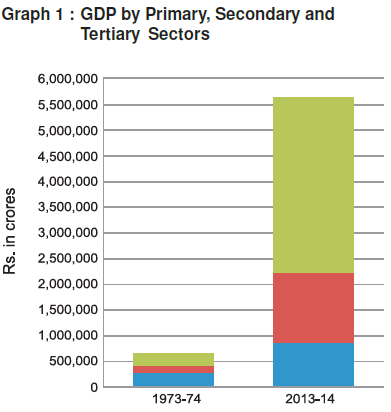
- Graph 1 illustrates the production of goods and services across three sectors.
- This data is presented for two specific years: 1973-74 and 2013-14.
- The choice of these two years is based on the comparable and authentic nature of the data.
- The graph highlights the growth in total production over a period of forty years.
Rising Importance of the Tertiary Sector in Production
The tertiary sector overtook the primary sector as India's largest producing sector in 2013-14. The tertiary sector in India has been increasingly important for the following reasons:
- Hospitals, educational institutions, post and telegraph services, police stations, courts, village administrative offices, municipal corporations, defense, transportation, banks, insurance businesses, and other services are considered vital for everyone.
- Agriculture and industry expansion lead to the expansion of services such as transportation, commerce, and storage.
- As people's incomes rise, they expect more luxuries like dining out, tourism, shopping, private hospitals, private schools, professional training, and so on.
- During the recent decade, several new information and communication technology-based services have become increasingly important and indispensable.
However, The service sector in India is not growing uniformly for everyone.
- This sector employs a variety of people with different skills and education levels.
- On one side, there are a few services that require highly skilled and educated workers.
- On the other side, many workers are involved in services like:
- Small shopkeepers
- Repair workers
- Transport workers
- These individuals often struggle to earn a living.
- They continue to work in these jobs because there are few alternative job options available.
- As a result, only a portion of the service sector is becoming more important.
- More details about this will be provided in the next section.
Disguised Unemployment: This term refers to a situation where unemployment does not affect overall output. It occurs when productivity is low and there are too many people for the available jobs. This can happen in any group of people who aren't using their full potential.
Where are most of the people employed?
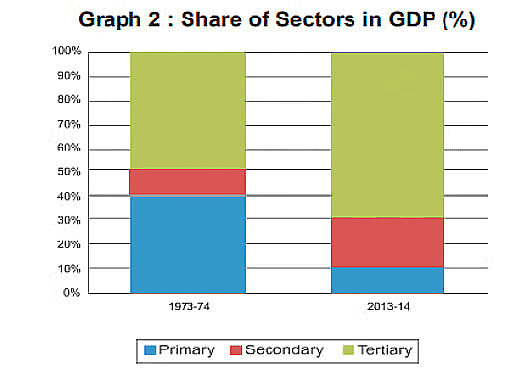
- Graph 2 shows the percentage of GDP that comes from three different sectors.
- It highlights how the importance of these sectors has changed over a period of forty years.
- Even though the share of GDP from each sector has varied, the patterns of employment have stayed mostly the same.
Lack of Shift in Employment:
- Graph 2 shows the percentage contribution of sectors to GDP, indicating shifts in sector importance over forty years.
- Despite increased industrial output (nine times), employment in the industry grew only three times.
- Service sector production rose 14 times, but employment grew five times.
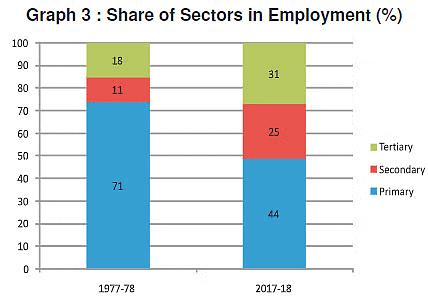
- Graph 3 shows how jobs are spread out among three sectors during two different years: 1977-78 and 2017-18.
- The primary sector still employs the most people compared to the other sectors.
- This data helps to understand how employment in various sectors has changed over the years.
- The comparison highlights the trends in job distribution from the past to the present.
Current Employment Distribution:
- Graph 3 shows the employment share in the three sectors for 1977-78 and 2017-18, confirming the primary sector as the largest employer.
- More than half of workers are in the primary sector (mainly agriculture), contributing about one-sixth of GDP.
- The secondary and tertiary sectors produce the rest of the GDP but only employ about half the workforce.
Underemployment in Agriculture:
- There is a high number of workers in agriculture compared to actual production needs.
- Additionally, some individuals are entirely unemployed.
- This underemployment can also occur in other sectors.
Impact of Removing Underemployed Workers:
- Removing a few workers from agriculture does not affect production but can increase family income through other jobs.
- For instance, if Laxmi’s family members find work elsewhere, they earn extra income without reducing farm productivity.
- Many small farmers in India experience similar underemployment problems.
- Reducing the agricultural workforce and providing better opportunities elsewhere can enhance overall income without compromising agricultural output.
Underemployment in Other Sectors:
- Casual workers in urban services often endure irregular employment.
- Examples include individuals in occasional jobs or low-income street vendors with limited options.
How to Create More Employment?
- Every state or region has the potential to boost income and employment opportunities for its residents.
- Areas such as tourism, regional crafts, and new services like IT can contribute significantly.
- According to NITI Aayog, research from the Planning Commission suggests that around 20 lakh jobs could be created in the education sector alone.
- In 2005, the Mahatma Gandhi National Rural Employment Guarantee Act (MGNREGA) was introduced by the Indian central government to implement the Right to Work across approximately 625 districts.
- This Act prioritises work types that will help enhance production from land in the future.
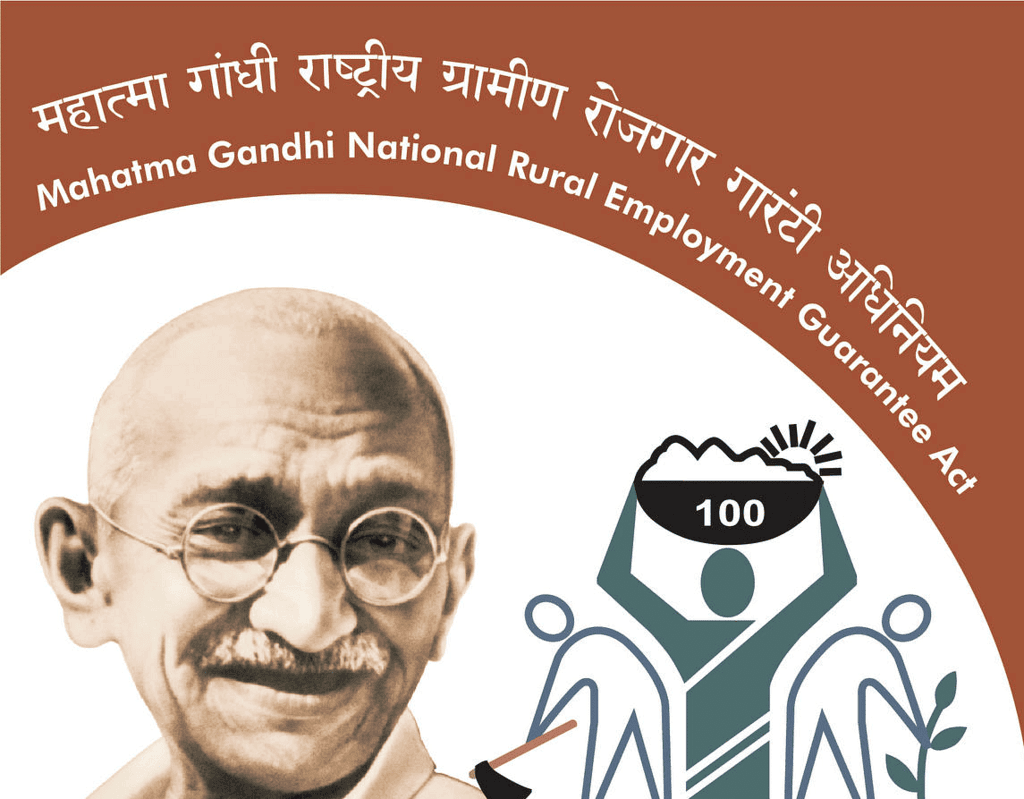
MGNREGA (2005)
- It primarily serves individuals in rural areas who are willing to work.
- It is known as the Mahatma Gandhi National Rural Employment Guarantee Act 2005 (MGNREGA 2005).
- Each year, the MGNREGA provides at least 100 work days to rural households that voluntarily engage in unskilled work.
- The MGNREGA scheme is available to any Indian citizen over the age of 18 residing in rural areas.
- Another aim of the MGNREGA act is to provide rural communities with long-term assets such as roads, wells, and ponds.
- If the government fails to generate jobs, people may have to rely on unemployment benefits.
- It is implemented without contractors or agents in gram panchayats.
- This law supports environmental preservation, rural women's empowerment, social equality, reduces urban migration, and provides essential services, among other benefits.
Division of Sectors as Organised and Unorganised
Example: Consider working condition of Kanta and Kamal
Kanta works in an office with set hours from 9:30 a.m. to 5:30 p.m. She receives a regular monthly salary, along with benefits such as a provident fund, medical allowances, and paid holidays (including Sundays). Upon starting, she was given an appointment letter detailing her job terms. Kanta works in an organised sector.
Kamal, Kanta’s neighbour, is a daily wage labourer at a grocery shop. He works long hours from 7:30 a.m. to 8:00 p.m. Kamal does not receive additional benefits or paid holidays and is only paid for the days he works. He lacks a formal appointment letter and can be dismissed at any time. Kamal works in an unorganised sector. The unorganised sector is characterised by small, scattered units largely outside government control.
1. Organized Sector:
- Organised sectors provide fixed and secure employment.
- These industries are registered with the government and must follow its rules and regulations, as outlined in various laws such as the Factories Act, Minimum Wages Act, Payment of Gratuity Act, and Shops and Establishments Act.
- Employees in the organised sector enjoy job security and receive pensions upon retirement.
2. Unorganized Sector:
- The government appears to have little control over the unorganised sector. Although there are rules and regulations, they are often not followed.
- Workers in the unorganised sector do not have the same level of job security as those in the organised sector.
- Overtime work is not compensated in any way.
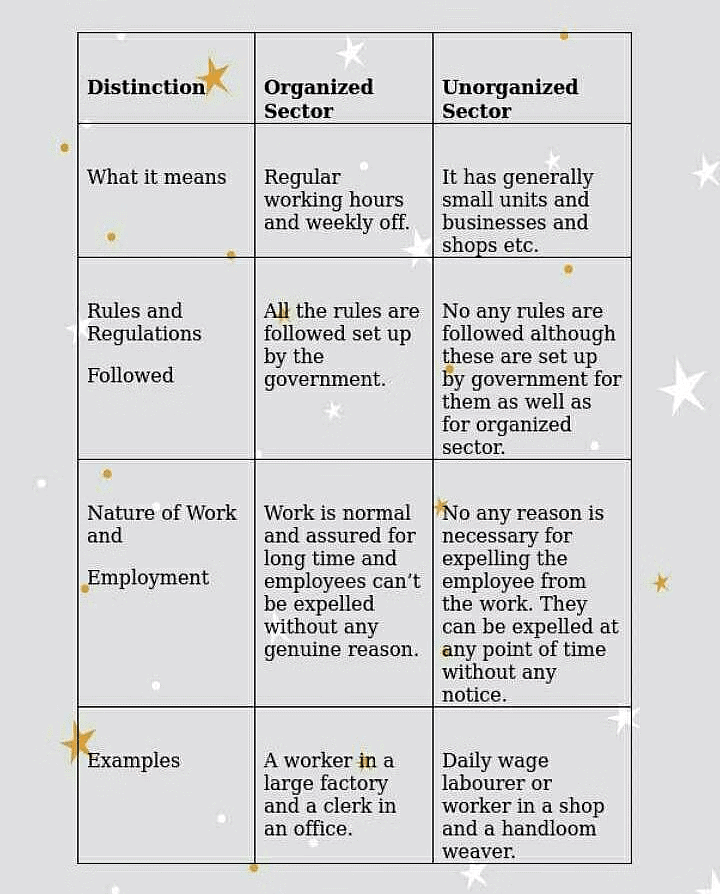
How to Protect Workers in Unorganised Sector?
The organised sector is known for providing desirable jobs, but its growth has been slow. Many businesses in the unorganised sector use tactics to avoid taxes and ignore laws that protect workers. Consequently, numerous individuals are compelled to take unorganised sector jobs, which offer very low salaries. Their earnings are often inconsistent and insecure, lacking benefits. Since the 1990s, many workers have shifted from the organised sector to the unorganised sector, resulting in lower wages. This situation underscores the need not only for more job opportunities but also for protection and support for workers in the unorganised sector.
Vulnerable Groups in the Unorganized Sector
Rural Areas:
- In rural areas, the unorganised sector mainly includes landless agricultural labourers, small and marginal farmers, sharecroppers, and artisans such as weavers, blacksmiths, carpenters, and goldsmiths.
- Approximately 80 percent of rural households in India are small and marginal farmers. These farmers require support through timely delivery of seeds, agricultural inputs, credit, storage facilities, and marketing outlets.
Urban Areas:
- The unorganised sector in urban areas comprises workers in small-scale industries, casual workers in construction, trade, and transport, as well as street vendors, head load workers, garment makers, and rag pickers.
- Small-scale industries also need government assistance for obtaining raw materials and marketing their products. Casual workers in both rural and urban settings require protection.
Social Discrimination:
- Workers from scheduled castes, tribes, and backward communities are often found in the unorganised sector.
- In addition to facing irregular and low-paid work, these workers also deal with social discrimination.
Sectors in Terms of Ownership: Public and Private Sectors
1. Public Sector:
- Ownership and Control: Government owns most assets and provides services.
- Purpose: Focuses on public welfare, not just profit. Funded through taxes.
- Examples: Railways, post offices.
Government's Role:
- Infrastructure Development: Invests in roads, bridges, railways, harbours, and electricity generation. These require large sums of money and are often beyond private sector capacity.
- Support for Industries: Provides affordable electricity to prevent small-scale industries from shutting down and buys and stores agricultural products to sell at lower prices.
- Human Development: Provides essential services like health and education. Ensures the availability of safe drinking water, housing, and nutrition for the poor.
- Challenges: The Private sector may not provide certain essential services at reasonable costs, necessitating government intervention.
2. Private Sector:
- Ownership and Control: Owned by private individuals or companies that provide services.
- Purpose: Focused on making a profit, with consumers paying for products and services.
- Examples: Includes companies like Tata Iron and Steel Company Limited (TISCO) and Reliance Industries Limited (RIL).
Characteristics: Activities are guided by profitability. Government sometimes supports private sector activities to ensure they are viable or to reduce costs for consumers.
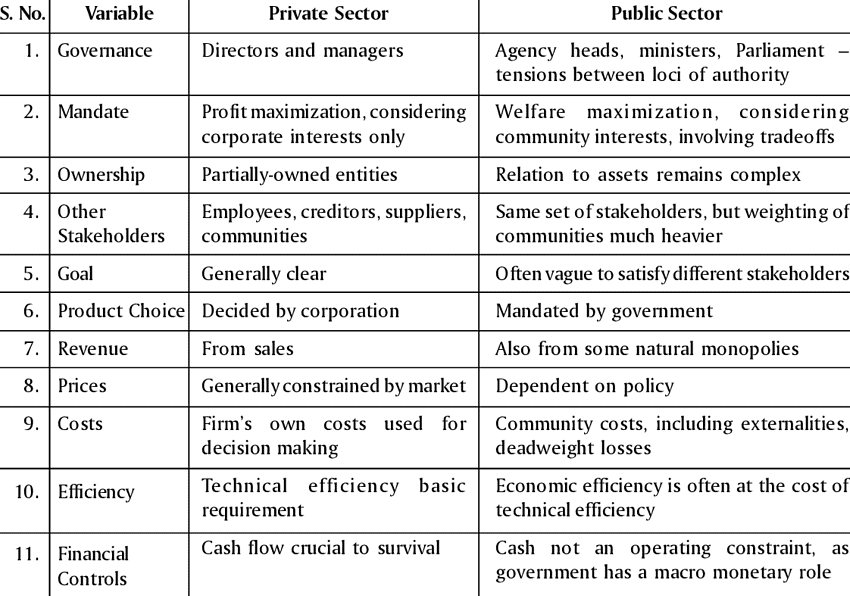
Summary
In this chapter, we explored how to classify economic activities into meaningful groups. One method is to categorize these activities into primary, secondary, or tertiary sectors. Over the past thirty years in India, data shows that while the tertiary sector contributes the most to the Gross Domestic Product (GDP), the majority of employment still resides in the primary sector. We also discussed various ways to enhance employment opportunities in the country.
Another classification involves distinguishing between organized and unorganized sectors. A significant portion of the workforce is employed in unorganized sectors, making it crucial to provide them with necessary protections. Additionally, we examined the differences between private and public activities, emphasizing the importance of public activities focusing on specific areas for the greater good.
|
66 videos|793 docs|79 tests
|
FAQs on Class 10 Economics Chapter 2 Notes - Sectors of the Indian Economy
| 1. What are the three main sectors of economic activities in India? |  |
| 2. How are the sectors of the economy divided into organised and unorganised sectors? |  |
| 3. What is the difference between public and private sectors in terms of ownership? |  |
| 4. Why is the tertiary sector important for the Indian economy? |  |
| 5. How have the contributions of the primary, secondary, and tertiary sectors changed in India over time? |  |


